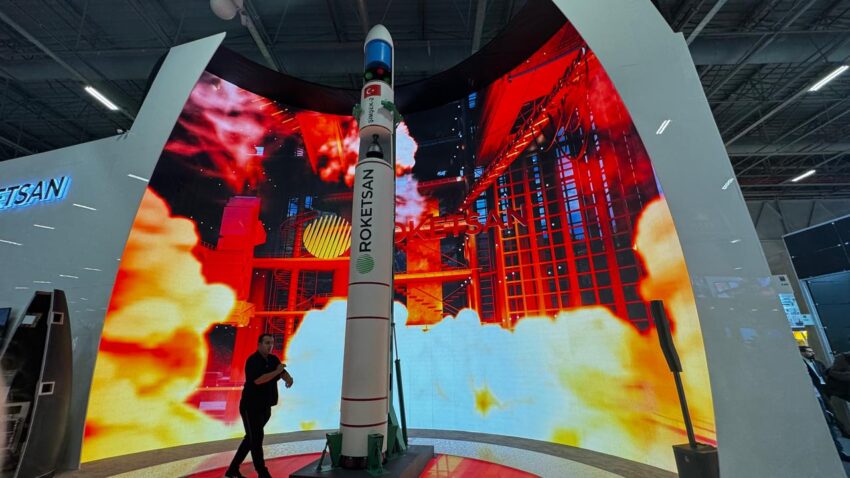A 1:6 model of the Simsek-2 Space Launch Vehicle unveiled by Turkish firm Roketsan at IDEF 2025. (Agnes Helou/Breaking Defense)
IDEF 2025 — Turkish missile firm Roketsan today signed an agreement with Indonesia to transfer the production technology of its Cakir cruise missile to Jakarta, while also using the second day of Turkey’s IDEF event to unveil five new missile designs and a space launch vehicle.
During a ceremony held today, Roketsan and Indonesia inked the agreement on Cakir, but the two sides did not announce details of dollar figure or number of missiles, not lay out how the agreement would work in terms of whether Indonesia can produce the weapons in-country.
It’s a move that lines up with comments from Turkish president Recep Tayyip Erdogan, who yesterday at IDEF underlined Turkey’s defense cooperation with countries as mutually beneficial partnerships.
“The issue is not just about making purchases,[…] what truly matters is establishing lasting collaborations built on a win-win foundation,” he said, according to local media.
The firm also used the show to unveil a series of new missiles, all in various states of development. These include:
- The GOKBORA air to air missile, which the company said has “beyond visual range” up to 185 km
- The EREN high-speed loitering munition with a range exceeding 100 km
- The 300 ER, which is an air-launched ballistic missile that can attack targets up to 50 km
- The Tayfun 4 missile, which the company described as “hypersonic.” An upgraded version of the Tayfun missile with a bigger warhead and larger dimensions (10 meters long and over seven tons), the company said in a statement that the missile is designed to neutralize “air defense systems, command and control centers, military hangars, and other critical military infrastructure from long distances.”
None of the missile unveiled are part of the Turkish integrated air defense project Steel Dome, according to the company.
On the naval side, Roketsan unveiled a new submarine-launched missile, dubbed the AKATA Encapsulated Atamca. Operating with both solid and liquid fuel, the system takes Roketsan’s existing Atamca missile and integrates it in a capsule which allows it to move in the water at a launch depth up to 60 meters. Then the head and capsule disconnect, and the Atamca missile launches from the water to attack its target.
The company also showed off a 1/6 scale model of its in-development Simsek-2 space launch vehicle. An upgraded version of the Simsek 1 which is scheduled to take first flight test in 2027, Simsek 2 will have a payload capacity of 1.5 tons while carrying remote sensing and auto-observation satellites.
“The rising military conflicts and security crises in our region in recent years have once again highlighted the critical importance of advancing Türkiye’s defense capabilities,” Roketsan CEO Murat Ikinci in a statement.

Tayfun 4 hypersonic missile design on display at IDEF 2025. (Agnes Helou/Breaking Defense)

The AKATA Encapsulated Atamca submarine launched missile at IDEF 2025. (Agnes Helou/Breaking Defense)
Click this link for the original source of this article.
Author: Agnes Helou
This content is courtesy of, and owned and copyrighted by, https://breakingdefense.com and its author. This content is made available by use of the public RSS feed offered by the host site and is used for educational purposes only. If you are the author or represent the host site and would like this content removed now and in the future, please contact USSANews.com using the email address in the Contact page found in the website menu.








